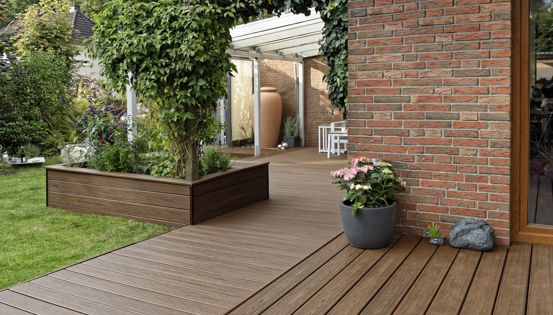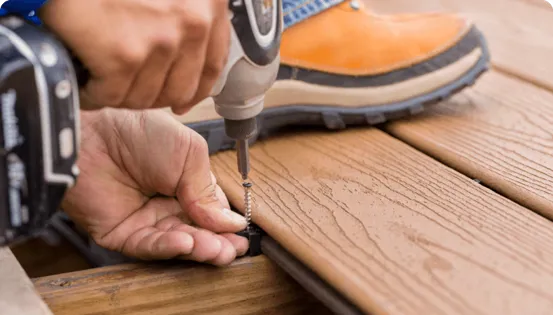Paints last longer on decks than stains, but they too eventually crack, chip, and peel. If limited to a small area of your wood deck, it’s easy to scrape and sand just that section. Large-scale failures require a more thorough approach and as a result, you may want to hire a professional. Here’s what to know about getting the paint off your wood deck.
Common Methods of Removing Paint from a Deck
You can remove paint chemically with paint strippers or mechanically by scraping, power washing, and sanding your deck. Deck-maintenance pros prefer chemical strippers and power washers because they’re much faster and less laborious than using strictly mechanical methods.
Chemical Methods
Paint strippers penetrate the wood grain better than scraping and sanding and these products have come a long way since methylene chloride. Look for water-soluble, low-VOC formulations that don’t emit unpleasant odors. At the same time, be sure the paint stripper is potent enough to dissolve paint. Paint is more stubborn than stain.
Mechanical Methods
It’s possible to strip deck paint without chemicals, but it’s more work. Plus, every job will require some sanding no matter what. While a power washer can be a big timesaver, you shouldn’t count on it to strip untreated paint. A belt sander, random orbital sander, angle grinder, and/or power planers are better choices. Heat guns are less desirable. Whatever the tool, keep in mind that most deck boards are pressure-treated softwood. Avoid leaving deep scuffs or divots.
Materials Needed
Calculate the square footage of your deck to determine how much paint stripper and how much cleaner/neutralizer to buy. Check your supply of sandpaper and see about renting or borrowing a power washer if you don’t own one. Or, just use a garden hose fitted with a jet nozzle. Protect your eyes, skin, and lungs by wearing gloves, safety glasses, and a mask.
Materials and tools
- Long-sleeve shirt
- Safety glasses
- Rubber gloves
- Mask or respirator
- Stripper suitable for paint
- Cleaner/neutralizer
- Scraper(s)
- Putty knife
- Pressure washer or garden hose
- Paint brush
- Garden sprayer
- Random orbital sander
- Detail sander
- Sandpaper (variety of grits)
- Nylon-bristle brush
- Shop vacuum
- Leaf blower
- Wood putty
Step-by-step Guide to Remove Paint from Deck
Removing paint from a deck is a big chore. Plan your work, stage the materials, and take it one step at a time.
Step 1: Prep Your Deck
After clearing the deck of furniture, potted plants, etc., inspect it for rot and make any necessary repairs. Take care of any popped nails or screws. Next, with a hand scraper, remove the worst of the flaking paint. Last, cover nearby shrubs with a tarp and mask off the siding and trim of the house using poly film and tape.
Step 2: Apply Paint Stripper to Deck
Paint strippers are typically either a gel that you apply with a paint brush/roller or a liquid that you dilute and apply with a garden sprayer. Gels cling better and tend to hold their moisture better. Don’t skimp on applying the stripper but don’t be sloppy either. Work in small sections, nothing larger than 10 by 10 feet. Apply more stripper or mist water over any areas drying too quickly.
Step 3: Remove Paint from Deck
Follow the manufacturer’s directions and give the paint stripper plenty of time to work. Occasionally test a few areas to see how well the paint lifts off. If using a power washer, don’t overdo it by getting too close to the wood or setting the pressure too high.
The gentlest method is to scrape off most of the paint with a putty knife and then scrub with a stiff-bristled nylon brush. This method works best while the surface stays moist. Using a power washer is faster, but it also requires wrangling equipment and hoses, which some people would rather avoid.
Removing paint from the top of deck boards is fairly easy. It’s more work to remove paint at the corners, deck board sides, and railings. Don’t go overboard trying to get every last bit. If the old finish is well adhered, you can paint right over it.
Step 4: Rinse Deck and Let Dry
Rinse the deck with fresh water or use a cleaner brightener/neutralizer to remove the paint stripper residue and then rinse. Let the deck dry thoroughly, which could take several days depending on conditions.
Step 5: Sand and Prep Deck for New Finish
If the paint stripper, power washer, and nylon brush didn’t get enough of the paint off, use a belt sander, angle grinder, or random orbital sander. An orbital sander is a good option for removing any fuzzy wood fibers left behind from pressure washing. Make sure to select the right grit. You shouldn’t have to go much finer than 150. Wear a mask or respirator and use a leaf blower or shop vacuum to remove dust. Lastly, fill any gouges with wood putty, and your deck is ready to stain or repaint.
Start your search for a local professional to strip and refinish your deck with Decks.com Find a Builder tool.
To find local retailers of composite decking and accessories, use the Decks.com Find a Retailer tool.







